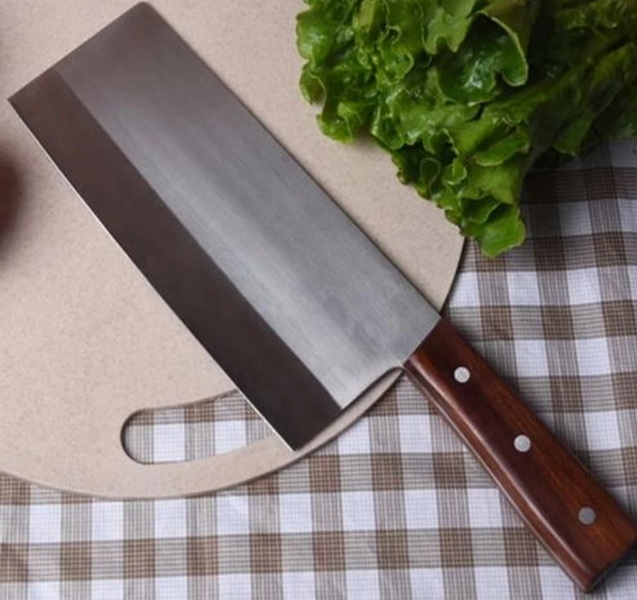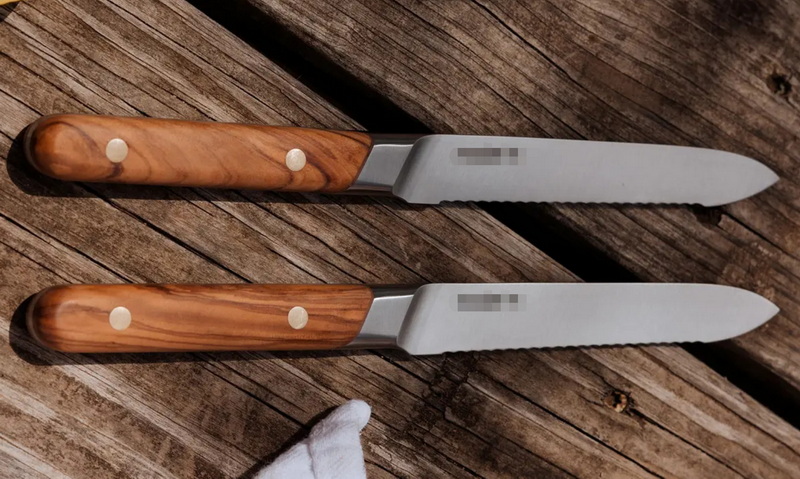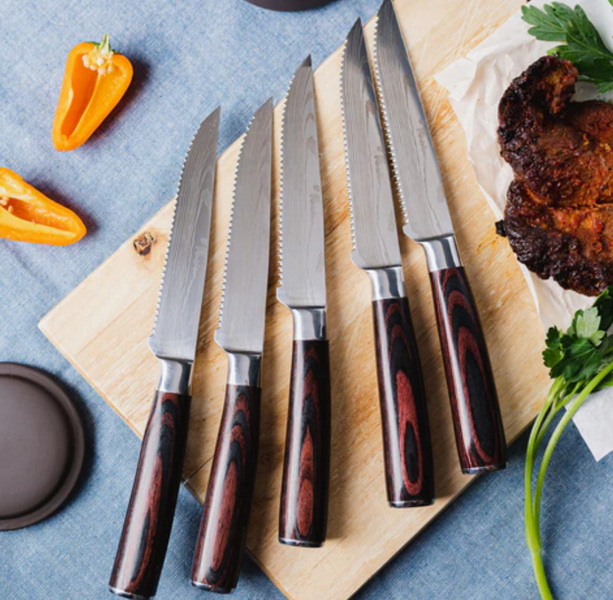- All
- Product Name
- Product Keyword
- Product Model
- Product Summary
- Product Description
- Multi Field Search
Views: 222 Author: Ann Publish Time: 2025-10-27 Origin: Site











Content Menu
>> Intended Use: Table vs Prep
● Design Considerations for OEM Partners
>> MOQ, Customization, and Branding
● Frequently Asked Questions (FAQ)
>> 1: What is the main practical difference between Steak Knife and Chef Knife?
>> 2: Are Steak Knives serrated or straight-edged?
>> 3: Can a Chef Knife double as a steak knife?
>> 4: How should Steak Knife be cared for to maintain edge?
>> 5: Which tasks are best left to a Chef Knife versus a Steak Knife?
Steak Knife plays a pivotal role in the dining experience, but the kitchen often requires a broader toolset, where Chef Knife excels as a multi-purpose workhorse. For OEM partners serving international brand clients, understanding the real differences between Steak Knife and Chef Knife is essential to guide product line decisions, packaging strategies, and education materials. This article provides a comprehensive comparison, focusing on design, materials, performance, maintenance, and practical guidance for branding and packaging in global markets. The goal is to help manufacturers position Steak Knife within a complete knife lineup while ensuring flow, readability, and persuasive value for buyers and end users alike.

- Chef Knife typically ranges from about 6 to 12 inches in blade length, featuring a broad, curved profile that facilitates rocking cuts and versatile prep work. This shape supports slicing, dicing, mincing, and chopping across a wide variety of ingredients, from vegetables to proteins. By contrast, Steak Knife is usually shorter, commonly 4 to 7 inches, with a straight or gently curved blade designed to deliver controlled, precise cuts at the table. The shorter blade length enhances maneuverability and reduces the need for large arm movements when portioning cooked meats at the tabletop. For OEM applications, this distinction informs packaging narratives and display strategies that emphasize different use-cases and ergonomics.
- Edge geometry differentiates a Steak Knife from a Chef Knife. Chef Knives are predominantly straight-edged for general prep tasks, delivering robust performance across many foods at a faster pace. Steak Knife offerings include serrated and straight-edged variants. Serrated Steak Knives grip and saw through the fibrous surface of cooked meats with less pressure, making them excellent for table service and casual dining. Straight-edged Steak Knives cut cleanly, delivering precise slices that preserve moisture and presentation on premium cuts. Maintenance expectations differ: serrated edges require specific sharpening approaches and tools, while straight edges can be maintained with conventional sharpeners. These distinctions influence consumer perception, price positioning, and service instructions in OEM programs.
- The intended use of each knife category shapes purchase decisions in both consumer kitchens and professional settings. Chef Knife is a core prep tool, suitable for a wide range of tasks including chopping, slicing, and mincing. Steady performance across diverse ingredients makes it a staple in culinary workflows. Steak Knife, however, is purpose-built for the dining table: it complements the service of cooked meats, enables diners to portion final servings with ease, and contributes to table aesthetics. For brands focusing on alignment with dining culture in different markets, the Steak Knife versus Chef Knife distinction is a storytelling opportunity that supports cross-category bundles and retailer education.
- Both Steak Knife and Chef Knife benefit from modern steel innovations. Stainless steels offer corrosion resistance and ease of maintenance, while carbon steels may promise sharper edges and easier sharpening but require more careful care to prevent rust. Damascus (Damasteel) blades bring aesthetic appeal and unique edge characteristics, often appealing to premium segments. In OEM contexts, presenting material options as a spectrum—from durable stainless to high-end Damascus—enables tailoring to budget- and premium-oriented markets. The choice of blade material affects edge retention, corrosion resistance, and maintenance frequency, all of which influence packaging content and care instructions.
- Handle design influences comfort, balance, and control during extended use. Ergonomics considerations include grip texture, palm swell, and weight distribution. For Steak Knife, a comfortable, slightly lighter handle supports long dining sessions without fatigue. Chef Knife handles may be designed to accommodate longer prep sessions, offering a secure grip for rapid, multi-directional cuts. In OEM projects, customizing handle materials (wood, pakkawood, G10, plastic) and finishes while maintaining hygienic standards can create differentiated product lines that resonate with global buyers.
- Cutting technique highlights the practical differences between Steak Knife and Chef Knife. Steak Knife excels in “light slicing” of cooked meats, reducing tissue damage and preserving flavor. Chef Knife enables “rocking cuts” and rapid meat breakdown during prep work, as well as versatile handling of vegetables and proteins. Demonstrations contrasting table-side slicing with tabletop prep illustrate why both tools coexist in a well-rounded kitchen toolkit. For marketing materials, include side-by-side video demonstrations that show texture, fiber response, and slice quality.
- Serrated Steak Knives often require sharpening with specialized tools to maintain tooth geometry, whereas straight-edged variants can be sharpened with standard whetstones or guides. Chef Knife maintenance generally involves regular sharpening to preserve a durable edge suitable for high-speed prep tasks. OEM communications should provide clear care instructions, including recommended sharpening schedules, storage solutions, and cleaning protocols to maximize life cycle value.

- Packaging should reflect the distinct roles of Steak Knife and Chef Knife within a brand's lineup. For Steak Knife, premium packaging that highlights dining experience, blade edge type (serrated vs straight), and ergonomic grip can reinforce consumer expectations at the point of sale. For Chef Knife, packaging can emphasize versatility, blade geometry, and performance across multiple cuisines. Visuals should include lifestyle images of table settings and prep environments to guide retailers and buyers in how these tools integrate into real workflows.
- OEM programs benefit from clear customization options: blade material choices, handle materials, logo placement, packaging branding, and engraving services. MOQ considerations should align with regional demand—some markets favor entry-level stainless options, while others seek high-end Damascus aesthetics with personalized branding. Providing modular configurations helps distributors assemble region-specific bundles that maximize conversion rates.
Steak Knife and Chef Knife occupy distinct yet complementary roles in both professional kitchens and consumer settings. The differences in blade length, edge geometry, and intended use inform how to structure product lines, packaging, and educational materials for OEM programs. A well-designed Steak Knife strategy, including serrated versus straight-edged options, robust handle ergonomics, and targeted maintenance guidance, can elevate table experience and consumer satisfaction without compromising the versatility of a Chef Knife. For brands pursuing a global presence, articulating clear distinctions, offering material and customization options, and delivering compelling visual content will support stronger retailer partnerships, higher conversion rates, and longer-term customer loyalty

- The Steak Knife is optimized for table-side slicing of cooked meats, emphasizing control and preserving meat texture, while the Chef Knife is a versatile prep tool designed for various kitchen tasks, including chopping, slicing, and mincing across ingredients. The two knives complement each other in a complete kitchen setup.
- Both variants exist. Serrated Steak Knives are popular for quickly cutting cooked meats at the table without requiring frequent sharpening, while straight-edged Steak Knives deliver cleaner slices when the goal is precision and presentation. Choice depends on meat type, service style, and brand positioning.
- In informal settings, a Chef Knife can substitute for a Steak Knife, especially for home cooks. However, for optimal control at the table and to protect meat texture, a dedicated Steak Knife often performs better for table service.
- Serrated edges typically require specialized sharpening tools and techniques, whereas straight-edged Steak Knives can be maintained with standard sharpening methods. Regular cleaning, thorough drying, and proper storage extend blade life and prevent corrosion.
- Chef Knife excels in prep tasks such as chopping vegetables, mincing herbs, and portioning proteins, while Steak Knife is ideal for cutting cooked meats at the table or during plated service. The combination supports efficient workflows in professional kitchens and clear consumer expectations in retail.
The Ultimate Professional Knives for Halal Butchery in Middle Eastern Kitchens
Chef Knife Size Guide: Choosing Between 6″, 8″, 10″, And 12″
Custom Knife Handles: How To Design A Chef Knife That Fits Your Hand Perfectly
Chef Knife Surface Treatments Guide: From Polished Migaki To Damascus Patterns
Inside Our Professional Knife Sample Room: Quality You Can See
Universal Knife Block Buying Guide: Modern Acrylic & ABS Knife Holders for Professional Kitchens
Universal Knife Block: The Complete Guide To Modern, Hygienic Knife Storage
The Complete Guide To Red Handle Knife Sets: Style Meets Functionality in The Kitchen
Professional Knives for Halal Butchery And Middle Eastern Cuisine